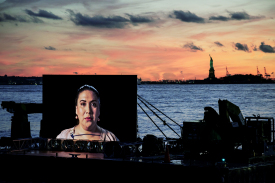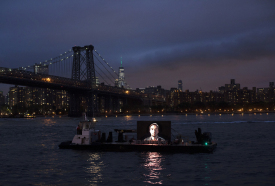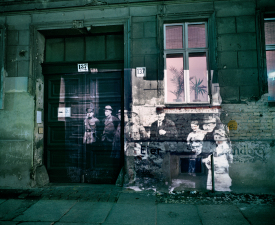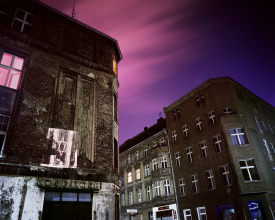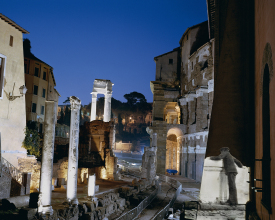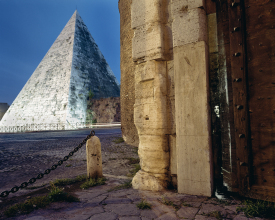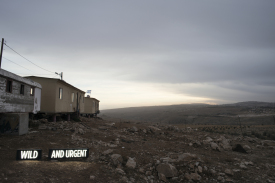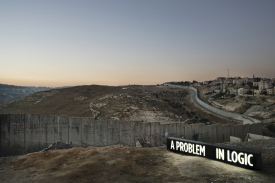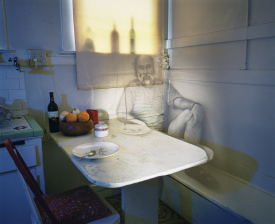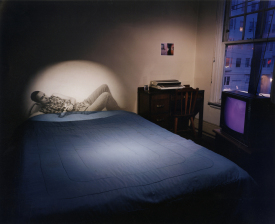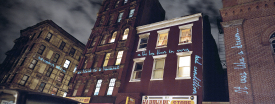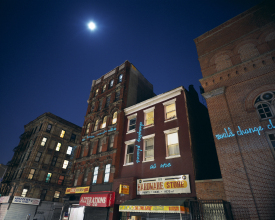Shimon Attie
by Dale Rosengarten
What once was and is no longer
Shimon Attie’s recurrent subjects are displaced persons: Jewish Berliners deported from their homes during the Holocaust; Danish Jews fleeing Copenhagen on fishing boats in 1943, juxtaposed with contemporary refugees seeking sanctuary in Denmark; Hispanic, Chinese, and Jewish immigrants resettled in Lower East Side tenements in New York; individuals from the international LBGTQI community and unaccompanied minors recently granted political asylum in the United States.
“A sense of displacement runs through all of my projects,” the artist explained in a recent interview. “There’s a sense of what once was and is no longer.”1
Attie’s public works peel back the past, like wallpaper, “to reveal the histories buried underneath.”2 Between 1991 and 1996, he created Sites Unseen, a series of installations in seven European cities—Berlin, Dresden, Hamburg, Copenhagen, Amsterdam, Cologne, and Krakow—reanimating particular locations with the memory of their murdered Jewish residents.
In The Writing on the Wall (1991–92), Attie merged photography and installation art by projecting pre–World War II photographs on buildings in one of Berlin’s former Jewish quarters, the Scheunenviertel, located in the eastern part of the city, close to Alexanderplatz. Visible to residents, motorists, and passersby, the projections beamed fleeting images of long-gone Jewish life in that neighborhood. The title of the piece serves as a warning to the people in the prewar photographs of what was to come.
Attie’s father’s father settled on the Lower East Side. For Syrian Jews, “that was their first port of call.” In Between Dreams and History (1998), the artist projected laser images of handwriting on the facades of tenement buildings to tell the communal narratives of various immigrant groups—Hispanics from Puerto Rico and the Dominican Republic, Chinese, and older Jewish residents—“all living in the same soup together.” He met with about seventy-five residents and asked them a series of questions, such as, “Have you ever had a sleeping dream about the Lower East Side, your neighborhood?”
From hundreds of pages of responses in four languages—Spanish, Mandarin, Yiddish, and English—Attie extracted twenty-eight short texts, then wove them together into one seamless passage, “almost like a poem.” What surprised him, he reports, were the common themes that emerged from every group: “they were all about displacement and a longing for home, a melancholy and longing to find home again.”
The History of Another (2002–3), enacted in Rome, reaches further back in time to “the long trajectory of the Judeo-Christian history and relationship . . . the grand and majestic history of the West, and empire, and the ruins of empire.” Attie’s Israel/Palestine project, Facts on the Ground (2013–14), has roots in his life: “I have a long history with that part of the world going back to my childhood. . . . I lived in Israel at different points in time, and I was very troubled by the political situation there, for example, by the occupation . . . by the taking of someone else’s land and justifying it based on biblical claims.”
He chose to deal with the fraught subject of “contested homelands that people have been spilling blood over for a long time” by installing thirty custom-made light boxes across Israel and Palestine, each containing a dramatic and enigmatic illuminated phrase—words such as WILD / AND URGENT and A PROBLEM / IN LOGIC. Some came from readings he condensed, but most were from his musings about issues of “land, territory, borders, nationhood, national identity, nationalism, religious and national fervor.” Here, too, he says, there is “a search for roots . . . looking for home in all of the right and wrong places, meaning they are ultimately unreclaimable.”
In Night Watch (2018), Attie decided to spotlight LBGTQI asylum seekers and minors who arrive unaccompanied at the border because these individuals are among the most vulnerable people on the planet. Silent video portraits of asylees emanate from twenty-foot-wide LED screens mounted aboard a slow-moving barge and tugboat that traveled the waterways around New York City.
Untitled Memory (1998), Attie’s most directly personal project, explored his own experience of displacement. After many years in Berlin, he returned briefly to his former home in San Francisco where he projected photographs he had made of old friends years before. Because he had lived in the Castro District during the height of the AIDS epidemic, some people interpreted the project “as arising from the AIDS crisis.” Although that was not what he was thinking about at the time, he says, “That’s fine . . . to throw another lens on it. . . . Just because I wasn’t necessarily thinking about that doesn’t mean it’s not so. . . . It’s not all just about the artist’s conscious motivation.”
Whether Attie’s choice of current domicile was conscious or unconscious, it seems fitting that he now lives in a former synagogue in New York’s East Village. Designed in 1908 for Congregation Beth Hamedrash Hagadol Anshe (“Great House of Study of the People of Hungary”), the building remained in use through 1975, was converted into co-op residences in 1985, and acquired landmark status in 2008: a perfect home base for a person of Shimon Attie’s spirit and sensibility.
1 Interview with Shimon Attie recorded by the author via Zoom, July 11, 2020. All quotes from Attie in the essay come from this interview.
2 “Shimon Attie,” Bildner Center for the Study of Jewish Life, Rutgers School of Arts and Sciences, https://bildnercenter.rutgers.edu/shimon-attie (accessed August 9, 2020).
Shimon Attie
Born in Los Angeles, California (1957)
Lives and works in New York City
Shimon Attie’s work reflects on the relationship between place, memory, and identity. His artistic practice includes creating site-specific installations in public places, accompanying art photographs, immersive multiple-channel video, and mixed-media installations for museums and galleries, and new media works. Attie earned a BA from the University of California, Berkeley in 1980 and an MA from Antioch University in 1982. He earned his MFA from San Francisco State University in 1991. Since that time, Attie has received more than 25 commissions to create new works of art in more than ten countries around the world.
Attie’s work can be found in the collections of museums around the world, including the Museum of Modern Art, New York, NY; National Gallery of Art, Washington, D.C.; Centre Georges Pompidou, Paris, France; and Tel Aviv Museum of Art, Israel, among many others.
He has received multiple honors including fellowships from the National Endowment for the Arts (1993), Stiftung Kunstfonds (1993), the Pollock-Krasner Foundation (1998), the American Academy in Rome (The Rome Prize) (2001), and the John S. Guggenheim Memorial Foundation (2008). In 2013-2014, Attie was awarded the Lee Krasner Lifetime Achievement Award.
Shimon Attie’s work was featured at the City Gallery at Waterfront Park in Charleston in 2005 in The History of Another, co-organized by the Halsey Institute.
Dale Rosengarten
Dr. Dale Rosengarten is the founding curator of the Jewish Heritage Collection and director of the Pearlstine/Lipov Center for Southern Jewish Culture at the College of Charleston. Rosengarten earned her BA and Ph.D. in the History of American Civilization from Harvard University. She curated the traveling exhibition A Portion of the People: Three Hundred Years of Southern Jewish Life, and, with Adam Mendelsohn, co-curated By Dawn’s Early Light: Jewish Contributions to American Culture from the Nation’s Founding to the Civil War. In spring 2019, with Shari Rabin and Michael R. Cohen, she directed a spectacularly successful NEH-funded institute titled “Privilege and Prejudice: Jewish History in the American South.”
While building an archives on southern Jewish history and culture, Rosengarten continues to pursue her other scholarly passion: the African American tradition of coiled basketry. Working as a guest curator for McKissick Museum, she developed the exhibition and book, Row Upon Row: Sea Grass Baskets of the South Carolina Lowcountry, which traveled the country for a record 20 years. In partnership with the Museum for African Art in New York, Rosengarten co-curated Grass Roots: African Origins of an American Art (2008–10), culminating with a six-month run at the Smithsonian Institution in Washington, D.C., and co-authored the companion volume.

